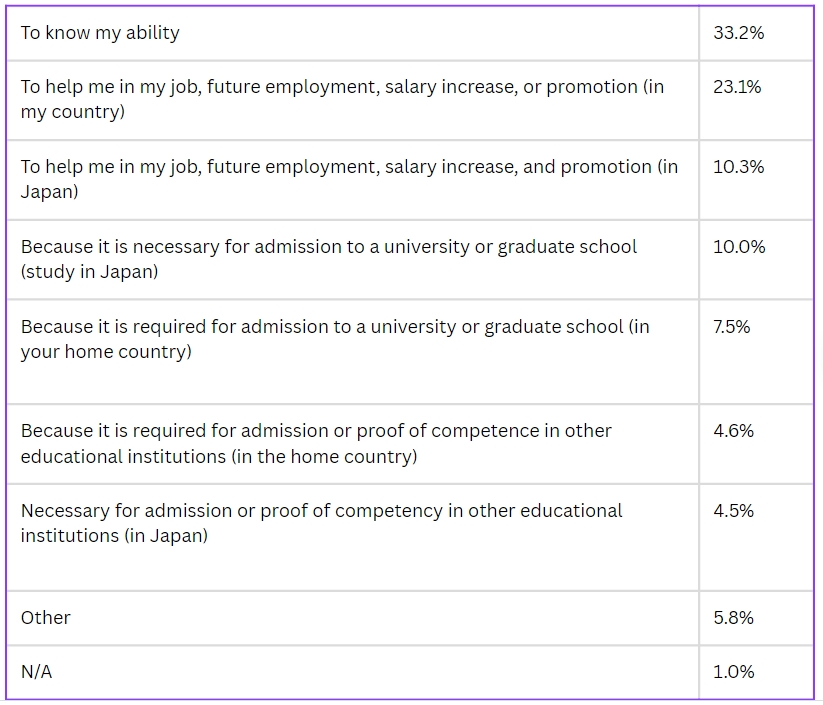Understanding the structure of the exam, mastering effective study techniques, and more to ensure your success in 2024.
Are you gearing up for the JLPT exam? Our extensive guide is here to help you grasp the exam format, utilize efficient study methods, and build the confidence needed to pass. Plus, learn how Toranomon Language School can support your preparation journey.

Index
What is the JLPT?
The Japanese Language Proficiency Test (JLPT) measures the Japanese proficiency of non-native speakers. Used by universities and companies, it is administered twice a year in various countries, including Japan. The five levels range from N5 (basic) to N1 (advanced). The test is commonly taken by those planning to live, work, or study in Japan.
Key Benefits of Taking the JLPT
Qualifications for Companies and Schools:
The Japanese Language Proficiency Test (JLPT) is widely recognized by employers and educational institutions in Japan and abroad as proof of Japanese language proficiency.
Career Opportunities:
Achieving higher levels of JLPT (N1 and N2) enhances your employment prospects in Japan and in companies that require Japanese language skills.
Professional Development:
For professionals in fields that use Japanese, obtaining a JLPT certificate supports career advancement and professional growth.
Education:
Many Japanese universities and schools teach classes in Japanese, requiring students to have understanding and conversational proficiency. Some institutions may require passing the JLPT or their own language test for admission.
Visa Applications:
While most visa applications don’t mandate Japanese language proficiency, demonstrating the necessary language skills is crucial for obtaining a work visa and performing job duties effectively.
Personal Achievement:
Passing the JLPT is a significant personal milestone and encourages further language study.
Cultural Integration:
High proficiency in Japanese fosters deeper cultural integration and a better understanding of Japanese society and culture.
Breakdown of reasons for taking the JLPT

Overview of JLPT at each level
N1 : Advanced
・Description: The highest level, measuring the ability to understand Japanese in various contexts.
・Reading: Comprehends complex texts like editorials and reports with intricate logical structures.
・Listening: Understands spoken Japanese in diverse situations, including long, complex dialogues on abstract topics.
N2 : Upper-Intermediate
・Description: Tests the ability to understand Japanese in everyday situations and various contexts.
・Reading: Understands materials on diverse topics, such as articles and simple critiques, grasping detailed content and author intent.
・Listening: Comprehends conversations, news reports, and lectures on general topics in everyday situations.
N3 : 中級
・Description: Bridges the gap between basic and advanced levels, measuring the ability to understand Japanese in everyday situations.
・Reading: Understand written materials on everyday topics, including newspaper headlines and simple explanations.
・Listening: Comprehends coherent conversations at near-natural speed, following daily conversations and main points of brief texts.
N4 : Elementary
・Description: Tests basic Japanese understanding, slightly more advanced than N5, focusing on everyday language.
・Reading: Understands passages on familiar topics with basic vocabulary and kanji, comprehending simple sentences and passages.
・Listening: Understands daily life conversations, provided they’re spoken slowly, following their content.
N5 : Beginner
・Description: Measures basic Japanese comprehension.
・Reading: Understands basic phrases, sentences, and expressions in hiragana, katakana, and basic kanji, comprehending short, simple texts.
・Listening: Understand familiar everyday expressions and basic phrases, catching keywords and phrases in slow, clear spoken conversations.
Test Structure
The JLPT comprises several sections based on the level:
1) Vocabulary (kanji, spelling, expressions, and paraphrases)
2) Grammar and Reading (forming sentences, using the right verb form, basic texts and reading comprehension)
3) Listening (Each level escalates in complexity and expected proficiency in these sections.)
*The test is administered biannually in many countries and is widely acknowledged as a Japanese language proficiency benchmark.
How long is the exam?
N1
Vocabulary, Grammar, and reading 110 min.
リスニング理解 55 min.
N2
Vocabulary, Grammar, and reading 105 min.
リスニング理解 50 min.
N3
Vocabulary – 30 min.
Grammar and reading – 70 min.
Listening – 40 min.
N4
Vocabulary – 25 min.
Grammar and reading – 55 mins.
Listening – 35 min.
N5
Vocabulary – 20 mins.
Grammar and reading – 40 min.
Listening – 30 min.
How is the JLPT scored? What’s the pass mark?
JLPT pass or fail hinges on meeting the overall score and specific criterion points. Missing any criterion, even with a passing overall score, results in failing the test.
N1
100 points/180 points
Language Knowledge 19/60 points
Reading Comprehension 19/60 points
Listening Comprehension 19/60 points
N2
100 points/180 points
Language Knowledge 19/60 points
Reading Comprehension 19/60 points
Listening Comprehension 19/60 points
N3
95 points/180 points
Linguistic Knowledge 19/60 points
Reading Comprehension 19/60 points
Listening Comprehension 19/60 points
N4
90 points/180 points
Language knowledge, Reading Comprehension: 38/120 points
Listening Comprehension: Standard score 19/60 points
N5
80 points/180 points
Language knowledge, Reading Comprehension: 38/120 points
Listening Comprehension: Standard score 19/60 points
Here are the main 10 points to remember for the JLPT preparation
1. Familiarize Yourself with the Test Format:
Understand each part of the JLPT – vocabulary, grammar, reading, and listening. Know how much each contributes to your final score and tailor your practice accordingly.
2. Build Your Vocabulary:
Immerse yourself in a wide range of vocabulary, including kanji, hiragana, and katakana. Use tools like flashcards or vocabulary apps to help with memorization.
For the kanji aspect, is possibly the most difficult part of the test, So please let us help you!
3. Get Grammar Down:
Feel confident with Japanese grammar by actively using it in constructing sentences and recognizing correct usage. Practice with grammar exercises specifically designed for your JLPT level. Be comfortable with conjugations.
4. Read Widely and Deeply:
Engage with various text types such as articles, essays, and dialogues to improve your comprehension skills. Pay attention not only to the content but also to the context and nuances.
If you want help from a Japanese teacher in your preparation, TLS has a special 1-month level up course
5. Sharpen Your Listening Skills:
Fine-tune your ears by listening to Japanese audio materials at different speeds and accents. Try mimicking native speakers and make use of resources like podcasts or language learning websites.
6. Master Time Management:
Practice pacing yourself to finish each section within the allotted time during practice tests. Develop strategies to efficiently tackle different question types while keeping track of time.
7. Take Practice Tests Seriously:
Replicate exam conditions by taking full-length practice tests. Analyze your performance to pinpoint areas of strength and weakness, then adjust your study plan accordingly.
8. Stay Consistent with Review:
Set aside regular sessions to review what you’ve learned. Use techniques like spaced repetition and create personalized study aids such as summaries or mnemonic devices.
9. Make the Most of Resources Available:
Utilize textbooks, online courses, and language exchange platforms to enhance your learning. Consider joining study groups or forums to share tips and practice with peers.
10. Keep Calm and Stay Confident:
Approach exam day with a positive mindset. Trust in your preparation, maintain focus, and tackle each question with confidence. Remember that stress can affect performance, so take deep breaths and stay composed.
lit. Ut elit tellus, luctus nec ullamcorper mattis, pulvinar dapibus leo.
For more information about applying for the exam, please visit this website: 日本語能力試験 JLPT
The best way to prepare for the test is by combining quality instruction from a good teacher with dedicated self-study. For the best teachers and solutions, reach out to Toranomon Language School!


